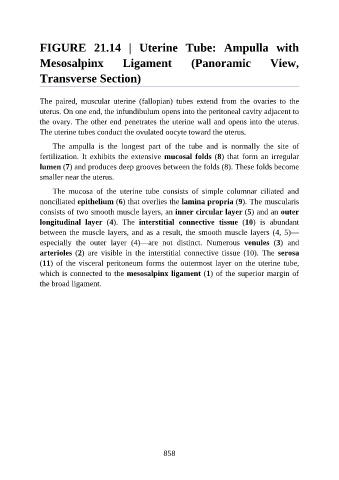Page 859 - Atlas of Histology with Functional Correlations
P. 859
FIGURE 21.14 | Uterine Tube: Ampulla with
Mesosalpinx Ligament (Panoramic View,
Transverse Section)
The paired, muscular uterine (fallopian) tubes extend from the ovaries to the
uterus. On one end, the infundibulum opens into the peritoneal cavity adjacent to
the ovary. The other end penetrates the uterine wall and opens into the uterus.
The uterine tubes conduct the ovulated oocyte toward the uterus.
The ampulla is the longest part of the tube and is normally the site of
fertilization. It exhibits the extensive mucosal folds (8) that form an irregular
lumen (7) and produces deep grooves between the folds (8). These folds become
smaller near the uterus.
The mucosa of the uterine tube consists of simple columnar ciliated and
nonciliated epithelium (6) that overlies the lamina propria (9). The muscularis
consists of two smooth muscle layers, an inner circular layer (5) and an outer
longitudinal layer (4). The interstitial connective tissue (10) is abundant
between the muscle layers, and as a result, the smooth muscle layers (4, 5)—
especially the outer layer (4)—are not distinct. Numerous venules (3) and
arterioles (2) are visible in the interstitial connective tissue (10). The serosa
(11) of the visceral peritoneum forms the outermost layer on the uterine tube,
which is connected to the mesosalpinx ligament (1) of the superior margin of
the broad ligament.
858

